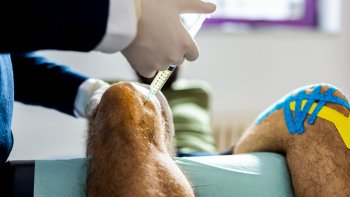
Arthritis is an unsettling diagnosis. Along with pain and stiffness come stress and frustration. You may feel that you’re losing control of your body and there’s nothing you can do about it.
At PRP Clinic at The Golab Center for Back & Joint Relief, we understand the importance of feeling your best. Platelet-rich plasma, or PRP, is a rapidly emerging treatment that can be used to reduce pain and improve joint function in those with arthritis.
Arthritis is a common condition affecting the joints – the point at which two bones come together. The exact mechanism and disease course of arthritis remains unclear. But we now understand that it’s not the result of just “wear and tear” of the joints.
Instead, a long chain of events in your body, involving a combination of various processes, leads to joint destruction and inflammation.1
The result? Bone-on-bone rubbing. This friction is responsible for shooting pain, swelling, and stiffness – all symptoms commonly attributed to arthritis.
A common misconception is that arthritis is a disease of old age, and that it’s inevitable.
While older age is certainly an important risk factor for certain types of arthritis, people of all ages and backgrounds can be affected.
According to the Centers for Disease Control and Prevention (CDC), 7.1% of people aged 18 to 44 years reported doctor-diagnosed arthritis between 2013 and 2015. Of people aged 45 to 64 years, the percentage jumped to 29.3%.2
Age isn’t the only risk factor for arthritis. Other common risk factors include:
Arthritis is common and expensive. In 2013, osteoarthritis was the second most expensive condition treated in the United States, totaling more than $140 billion in costs.2 It also cost $164 billion in lost wages.8
Despite the enormous costs, there are no curative therapies for arthritis.
Treatment focuses on relieving symptoms and slowing down the progression of your condition with various methods that might include:
Unfortunately, many patients don’t respond to medications. Many of these pharmaceuticals also come with undesirable side effects the longer you take them.
And while surgery may be an effective option, cost may be prohibitive. Furthermore, up to one-third of patients report experiencing chronic pain after surgery.1
It’s clear that arthritis sufferers need a new, revolutionary treatment – one that not only reduces pain but also has the potential to actually repair or regenerate cartilage.
Platelet-rich plasma, PRP for short, is a blood product that contains a high concentration of platelets suspended in a small amount of plasma.
Platelets are best known as a type of blood cell involved in clotting. When you’re injured, your blood vessels send out a signal that activates platelets, which then release bioactive proteins and growth factors. These factors play a major role in tissue regeneration and healing.1,9
But PRP takes your body’s innate healing capabilities one step further. Because the concentration of platelets in PRP is at least 2 times greater than in whole blood, the healing response is also much stronger.1
The various growth factors and chemicals stored in platelets have also been shown to:
Because of these properties, PRP injections have been gaining attention in surgery and sports medicine.13 And researchers believe that PRP can provide similar benefits to patients with arthritis.
Evidence of PRP’s benefits for arthritis treatment continues to mount. A meta-analysis examined 10 randomized, controlled clinical trials comparing PRP to other treatments in 1,069 patients diagnosed with knee osteoarthritis. The investigators found that patients treated with PRP injections had greater pain relief and functional improvement compared to those treated with other methods.14
The entire PRP process, which includes preparation and injection, takes approximately 1 hour. At PRP Clinic at The Golab Center for Back & Joint Relief, you can expect the following steps:
| Step One |
| A technician will draw a small sample (about 15 cc) of blood from you, which will be placed in a tube. |
| Step Two |
| The vial is placed in a centrifuge, which spins the blood at high speeds. This separates the platelets from the other blood components. |
| Step Three |
| We remove the tube from the centrifuge and separate the plasma layer from the other layers which are then discarded. |
| Step Four |
| Once the PRP solution is prepared, your provider will inject it into the affected area where the healing process begins. |
Because PRP triggers a cascade of biological responses, you may experience some soreness or swelling in the injection area for a few days. We recommend taking it easy for a few days after your treatment.
PRP is an autologous product, which means the healing substance comes from your own body.
This gives PRP an outstanding safety profile – with significant reductions in your risk of an immune reaction or disease transmission.
Platelet concentrations can be prepared to meet your unique needs, giving you much more room for personalization compared to other treatments.
Arthritis can be a life-changing diagnosis but your future doesn’t have to be filled with pain. You deserve a safe, effective solution.
If you’re in the San Antonio, TX area, call (210) 405-7820 today to experience the difference PRP can make in your life. We look forward to seeing you.
Call (210) 405-7820 today to learn what PRP can do for you.References: